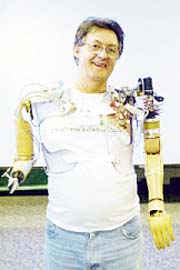The first bionic man

Science fiction fans remember well the character of Steve Austin, "the man worth millions" from the 80's TV series. In the series, Austin was an astronaut who was fatally injured in a plane crash, and subsequently his organs were rebuilt as a "better, stronger and faster" person.
Jesse Sullivan, a 58-year-old electrician from Tennessee in the United States, became the first "bionic man" in the real world. He lost both his arms in a work accident in which he was electrocuted, and lost all hope of ever being independent. However, two weeks after the accident, scientists at the Chicago Rehabilitation Center replaced Sullivan's left arm, and he was provided with a bionic arm - a mechanical device operated by his brain. "I would like to have my real arms back, but that's not going to happen anymore," Sullivan said.
Today, Jesse is able to eat and shave by himself, knit socks, put on his glasses, and most importantly: mow the grass in his garden. He is able to control even the precise movements required to open jars, and play ball with his ten grandchildren. "When I arrived in Chicago I was still suffering from the results of the accident and was full of fears, but now I feel wonderful. They gave me hope for the future," he said.
The neuro-engineering technology enables a connection, literally, between the machine and the person. The four main nerves that ran along Jesse's arms were severed at the shoulder and attached to his pectoral muscles. The nerves grew into the muscles, which allowed him to transmit sensations and instructions from his mind. He is able to raise the elbow, make a fist and open the palm, rotate it and lower it.
Sullivan's right arm was replaced by a normal prosthesis, and according to him, the old technology works well alongside the new - allowing him to operate the bionic arm for delicate operations, and use the right arm for more difficult jobs, such as lifting loads.
"The first artificial arm I received was made with technologies from the Second World War. I was discouraged," said Jesse. "Later I was offered to participate in the experimental surgery. I figured I'd lost both arms anyway, so I had no reason to resist. They said that I might lose the feeling in my chest muscles after they pass the nerves through them, but in any case I didn't use them, and for me it was an honor to be part of the project."
Over the years, Jesse has increased the number of actions he can perform, and along with technological progress, his motor skills are also progressing. "I don't put the arms together every day, but only when I have to do something specific," Jesse said.
This is the first time a neuromuscular transplant has been done to connect an artificial limb, and scientists are constantly working to improve the function of the arm. Today, Jesse can only feel his arm by touching his chest, which creates a sensation for him to touch his pinky or palm. The scientists are currently developing special sensors that will allow Jesse to sense the strength of his handshake, but this development is still in the laboratory work stages.
After Jesse, three other amputees participated in the trial of the new technology, and in two of the cases the future of the trial looks quite promising. The hope is that the technology, which today is still very expensive, will be developed and its cost reduced, so that it can be used more widely.
